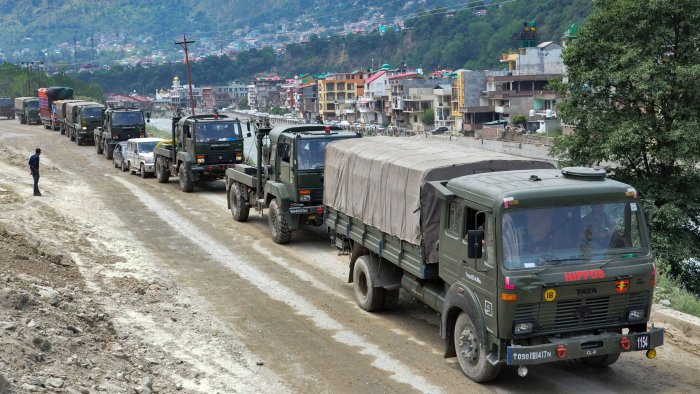‘Where Past Makes Rumours Reliable’: In The Land of ‘Khabri Zainakadal’

Adil Amin Akhoon is the Managing Editor at The Mountain…
In a place where a means of communication and movement is restricted due to political and climate instability, rumours driven by fringe discourses and heightened military footfall only make people restless.
The massive troop buildup termed as the ‘homecoming’ of paramilitary forces from the poll-concluded Indian states has made Imtiyaz Mir anxious. The new jackboots have purportedly followed the 2019 summer footsteps when additional forces were sent to the valley in the run-up to the abrogation of Article 370.
Two years later, 200 paramilitary companies have arrived, with most of them sent to north Kashmir having proximity with the ceasefire-calmed Line of Control.
This northern security stockpile is making Mushtaq speculative about the coming events that apparently have already cast their shadow.
“If a war-like situation emerges, north Kashmir will be the first casualty,” Imtiyaz fears. “We pray and hope that such things shouldn’t happen.”
The dangers and fears among people have already paved the way to anxiety. To stay calm in the current searing situation, people are trying to keep themselves busy in other activities.
Support Our Journalism
You are reading this because you value quality and serious journalism.
But, serious journalism needs serious support. We need readers like you to support us and pay for making quality and independent journalism more vibrant.
“But that doesn’t mean we’re unaware about the things being discussed on social media,” Imtiyaz says. “We choose to ignore it. I don’t know if it is total helplessness or our version of sensibility.”
People in the valley today feel that the government is going to take some radical administrative or political steps.
These fears surfaced after the killing of a Kashmiri Pandit councillor and the subsequent online summit calling for settlements in Kashmir. The extreme pitch was followed by the “security review” meeting of Lieutenant Governor Manoj Singh with Home Minister Amit Shah. The subsequent arrival of additional troops and a barrage of rumours triggered by the leaked circulars threatened to make another summer seething in Kashmir.
“They’re now routinely following this speculative summer script and keep Kashmiris on the edge,” Tufail Anjum, a school teacher, says. “These may be tested and dusted methods, but they’re working fine for them.”
Clearly, as the rumour mills have been set afire, the northern troop buildup has created the déjà vu feelings.
“What’re they up to now?” a 67-year-old grocer asks his regular customer in a northern town.
“Well, who can tell!” the customer responds with a clueless expression on his face.

The reaction of Kashmiris has a historical background. They look at everything with suspicion, and the helplessness in their arguments is the reflection of piled up trauma of decisions taken every now and then for them.
Back in bygone times, there was an adage in the Kashmiri language called Khabri Zainakadal.
For Kashmiris, the Khabri Zainakadal was more than a rumour and it had a probability that it may come true.

“The rumour culture has grown out of that Khabri Zainakadal adage today,” says Mohammad Sayeed Malik, a veteran editor of Kashmir. “There’s also a psychological and geographical factor which plays a key role in rumour belief.”
Right from the Mughal period, the rumours have been spread to gauge the mood and then bought things into action. There used to be agents of the rulers who used to spread rumours.
Aurel Stien, the English translator of Kalhana’s Rajtaragini, defines the Kashmir capital as a hotbed of “political gossip and fertile nursery of rumours”.
Walter Lawrence also believed that Kashmiris are like the Irish car-driver who tells quaint scandals of Kashmir and its rulers.
In 1889, the rumour spread like a wildfire that the Maharaja has been in correspondence with the Czar of Russia. Soon the imperial British—at loggerheads with Russians—levelled the charge against him.
But it was Lord Curzon who came to the Maharaja’s rescue, saying, “the state of Kashmir is so fertile in all its resources and has always been more productive of strange rumours than any other native State”.
The next day, Kashmir Post printed the headline in bold letters: ‘Kashmir-The Land of Strange Rumours.’
Historian Khalid Bashir Ahmed recalls the concluding days of Dogra Rule in his book—“Kashmir Looking Back In The Time”: “The popularity of Sheikh Muhammad Abdullah skyrocketed through a widespread rumour that his name was naturally imprinted on tree leaves. The incident was planned to show the supporters of Mirwaiz Mohammad Yusuf Shah, an adversary of Abdullah, down. Later on, the jeweller was probed about the truth and he exposed it was droplets of acid poured on mulberry leaves to make an impression of Sher-i-Kashmir Zindabad.”
In 1975, when Indira Gandhi imposed an emergency, Mohammad Sayeed Malik was Director Information. At that time, Malik vividly remembers premier Gandhi censoring all the newspapers. “As a director,” the seasoned newsman recounts, “I had to deal with censorship, and during censorship, you’ve to treat everything as a rumour, even hard news.”
Malik believes censorship breeds rumours and Kashmiris believe more in rumour rather than real news “because they’ve been brought up on that cultural diet”.
The past bitter experiences, apprehensions and fear makes people rely on rumours, says Yusuf Jameel, Kashmir’s ace newsman.
Back in the day, when Kashmir Times published a story in which a quote was attributed to a non-existent geologist warning Kashmiris that Takht-i-Sulaiman would erupt, people fled to safer places until another newspaper termed it “a cruel joke”.
“About the new rumours in the political market,” Yusuf says, “I talked to various officials about the troop buildup and they responded that they’re being redeployed for the Amaranth Yatra. But you never know what will happen in Kashmir.”
In fact, since 1947, the rumours are the pet official tool to check the reaction and predict the nature of dissent in masses, says Zareef A. Zareef, Kashmir’s celebrated chronicler.
“Rumours are tactics to tire the people and shock them later,” he says.
“However, after abrogation, rumours are like stripping socks from naked. It’ll serve no purpose to Babus.”

But a few days back, when rumours about the possible bifurcation of the valley spread on social media, it was a throwback to August 2019.
Amid heightened tensions in Jammu and Kashmir then, Governor Satya Pal Malik at that time said, “Only rumour-mongering is going on and there’s no reason to panic.”
The next day Kashmiris woke in a curfewed state and enveloped in the communication blackout.
“We know how rumour becomes a nightmare in Kashmir,” says a young scribe. “The rumours are ways of testing waters and more often to create threat perception.”
Back in north Kashmir, Imtiyaz Mir still feels that something big is brewing in Kashmir.
“The flux of troops in and out of the valley is a routine thing for people living in the mountain areas of north Kashmir, a region that has tens of thousands of troop presence owing to its geographic and strategic importance,” he says.
“The norm has been rushing of additional troops to the valley particularly at times of elections. However, the rumoured numbers such as ‘inflow of 200 companies’ triggers relapse of the August 2019 episode when some 800 companies were rushed to the erstwhile state of J&K and the rest is history. Lately, there has been some clarification on these speculations like ‘return of troops from election duty’ that has reduced the scope of any ‘redevelopment’ and associated rumours, here premature truths. Let’s wait for the truth to unfold.”
(Bisma Farooq, Rizwan Hameed contributed to this story.)
Mountain Ink is now on Telegram. Subscribe here.
Become Our Ally
To help us strengthen the tradition of quality reading and writing, we need allies like YOU. Subscribe to us.








